
Strasbourg’s Notre Dame Cathedral is a stunning masterpiece of Gothic architecture, renowned for its intricate façade, astronomical clock, and towering spire that was the tallest in the world from 1647 to 1874. Our favorite hotel near the Cathedral is Hotel Suisse.
The Best Area to Stay in Strasbourg
Visitors to the French city of Strasbourg, de facto capital of the Alsace region and seat of the European Parliament, are in for a pleasant surprise. Home to distinctive Alsatian half-timbered houses, a gorgeous Gothic cathedral, and narrow winding streets, it’s one of the most beautiful cities in Europe, ringed by canals and the tranquil waters of the River Ill. It also boasts one of the largest universities in France (students account for some 20 percent of the population), creating a dynamic, lively atmosphere that combines the best of German and French culture (the German border is a short ride across the Rhine).
At the heart of Strasbourg is the island created by the Ill River and its canals known as the Grande-Île. It’s the most beautiful part of the city and the most atmospheric place to stay; home to the magnificent cathedral, the Strasbourg Museum of Fine Arts, Historical Museum, and the picturesque neighborhood dubbed La Petite France, with its “Ponts Couverts” and medieval towers. You’ll find the city’s most luxurious hotels here, but there are a few bargains to be had as well.
La Petite France
The Gare-Tribunal district, anchored by the city’s main rail station, is a more convenient alternative for train travelers, with numerous budget and boutique hotels within walking distance of the station – but also not far from Grande-Île.
To the northwest, Neustadt and the European District offer dramatic contrasts to the medieval and traditional Alsatian architecture of Grande-Île. Neustadt was largely created by the Germans during the occupation of 1871–1918, studded with grand Neoclassical buildings including the Palais Universitaire de Strasbourg. The adjacent European District is a more contemporary, landscaped neighborhood home to the main European institutions based in Strasbourg: the Council of Europe, European Parliament, and the European Court of Human Rights. Both areas are fascinating to visit, but hotels are few.
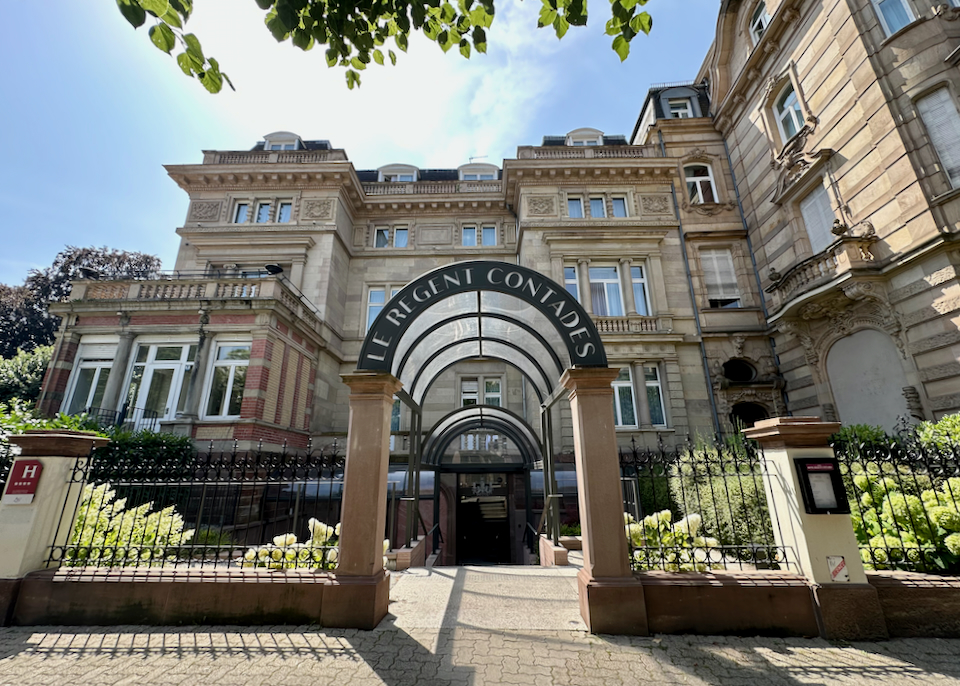
Hôtel Régent Contades is a refined 4-star hotel housed in a 19th-century neoclassical mansion in Neustadt, offering 48 elegant rooms and suites, a Belle Époque lounge, a cozy bar, and a wellness area with sauna and massage services, all just steps from the River Ill and the city’s historic center.
Finally, you might consider the smattering of generally high-end hotels south of the Grande-Île in the Bourse-Esplanade-Krutenau district. It’s a little quieter here, away from the main tourist trail, but still close to the main sights. In Krutenau itself there’s the excellent Musée Alsacien (Alsatian museum) and the stunning tiled facade of the Haute École des Arts du Rhin (School of Arts). You could also consider the modern hotels a bit further south in Neudorf, which offer much cheaper rates for relatively high levels of comfort.
The Best Places to Stay in Strasbourg
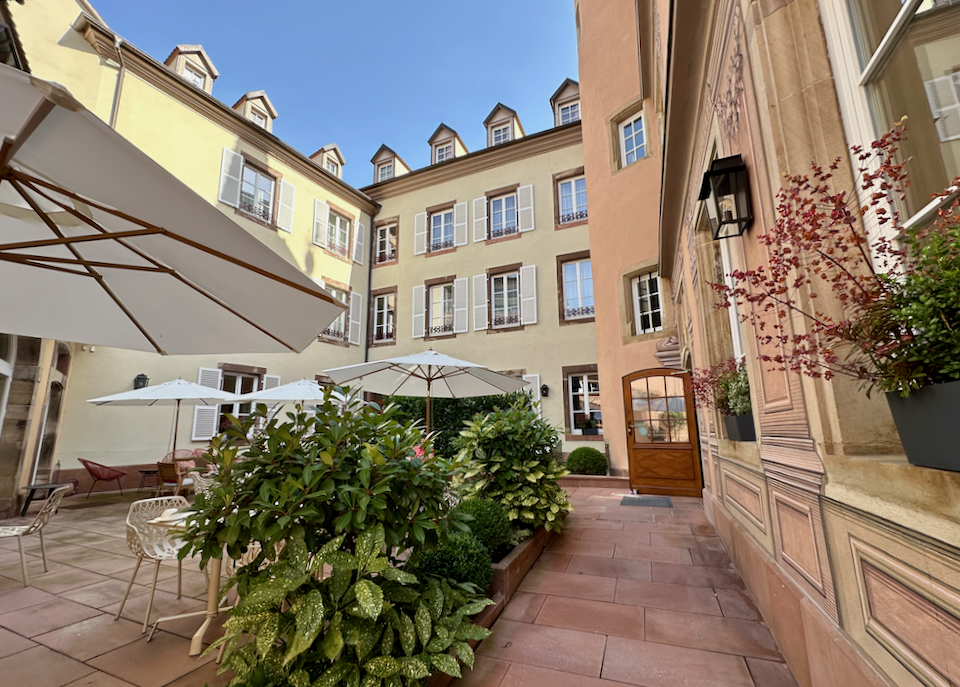
We love the charming courtyard terrace of Le Bouclier d’Or, a fantastic and centrally-located hotel (with spa) in La Petite France.
- Best Luxury Hotels in Strasbourg
Cour du Corbeau • Les Haras • Régent Petite France • Hôtel Suisse • Le Bouclier d’Or- Best Boutique Hotels in Strasbourg
BOMA • Boutique Hôtel des XV • Hôtel Arok • Hôtel des Vosges • Hotel Tandem • Hôtel LÉONOR • Villa La Florangerie- Best B&B in Strasbourg
Chambre d’hôtes La Célestine- Best Cheap & Midrange Hotels in Strasbourg
Hannong Hotel • Hotel de l’Europe • Hotel D • Hôtel Origami • ibis Centre RepubliqueBest Neighborhoods in Strasbourg for…
- Best Neighborhood to Stay in for First Timers/Sightseeing: Grande-Île
Strasbourg’s Grande-Île is at the heart of the city and home to the cathedral, museums, the best restaurants, shopping streets, elegant squares and the gorgeous Petite France neighborhood. It’s the most atmospheric place to stay in Strasbourg and easily the best for sightseeing, especially for visitors with a short amount of time. The choice of hotels is fairly extensive, from the most luxurious to budget inns, though quality in the latter group tends to be poor; if you’re looking to save money but maintain high standards of comfort, consider Krutenau or Neudorf to the south, or Gare-Tribunal to the east. The latter district, surrounding the main station, is also a lot more convenient for those traveling by train (Grande-Île hotels can be tricky to access by taxi, given the number of pedestrian zones); you’ll be able to walk to your hotel with luggage, but still be within strolling district of Grande-Île.- Most Romantic Neighborhood: La Petite France
The narrow, incredibly beautiful streets of Strasbourg’s iconic Petite France district are especially magical in the early mornings or around dusk, when the tourists start to disappear. Strolling its riverside parks and promenades allows for gorgeous views of the city and its Alsatian architecture, especially romantic in the moonlight. The panoramic terrace of Barrage Vauban is the best place to take it all in. Treat yourselves to the wonderful Régent Petite France or Bouclier d’Or hotels, and meals in the historic Maison Des Tanneurs or Le Thomasien French restaurant.La Petite France. The building with the blue windows is the Régent Petite France, which we especially recommend for a romantic getaway.
- Best Neighborhoods for Nightlife: Grande-Île and Krutenau
Strasbourg boasts a lively nightlife, largely thanks to its massive student population. Grande-Île is studded with bars, late night-cafes, and nightclubs, all popular with tourists as much as with the locals. Place Marcel Gayot is a great place to start; a small, beautiful square lined with open-air restaurants and bars, with popular Bar Barberousse a short walk away, and a cluster of spots on nearby Rue des Frères and Rue des Juifs (Académie de la Bière Cathédrale and wine bar Royal 26 Strasbourg are our favorites on the latter). On the other side of the cathedral the scene is more spread out, with Code Bar (which turns into a club at weekends), Les Tricheurs, Schluck N’Spiel, Les Berthom, and the 1950s-themed Jeannette and the Cycleux all well worth checking out.South of the river, Krutenau is perfect for bar-hopping, with a far more local scene. Highlights include Le 21 ShooterBar (a bar that literally specializes in shots), the cocktails at Bar Algorythme, the craft beers at Brasserie Au Télégraphe, the rock/metal at Bar L’Excalibur, and the decent Guinness at the obligatory Irish pub, Molly Malone.
- Best Neighborhoods for Food and Restaurants: Grande-Île and Krutenau
You’ll find the best restaurants and cafés spread throughout Grande-Île and Krutenau, with Strasbourg increasingly known as a cross-cultural foodie hotspot, though it still does French cuisine and traditional Alsatian cooking best. Places to splurge in Grande-Île include the highly-rated Au Crocodile, Les Chauvins Père & Fils, Perles de Saveurs, and Zehnerglock. It’s also hard to top Maison des Tanneurs for historic ambience and Alsatian food, while Au Cruchon is cozier and less formal.Over in Krutenau, the riverside restaurants and bars along the Quai des Pêcheurs are especially tempting in summer, while further into the neighborhood you’ll find a diverse crop of spots that include Umaï Ramen, MÂY (Vietnamese), Pitaya Thaï Street Food, and Vert Olive (Lebanese). There are plenty of fine dining establishments over here too, specializing in French and Alsatian food; Brasserie Des Haras, Fink Stuebel, Restaurant Gavroche, La Cuiller à Pot, and Restaurant 1741 are all excellent. Another standout if you’re looking for something different is Le Transsibérien, serving high-end Russian food.
We found lots of great restaurants in the area surrounding Place d’Austerlitz in Krutenau.
Strasbourg is the place to sample traditional Alsatian cuisine, which combines elements from both France and Germany (it’s also known as the birthplace of foie gras in 1780). Typical street snacks include tarte flambée or “flammeküche” (a bit like thin-crust pizza) and braided pretzels. Most Alsatian restaurants feature German-style pork, potatoes, and spaetzle (like pasta) dishes along with the classic “choucroute”, which is a bit like sauerkraut, usually served with smoked pork, ham, or sausages. Another favorite dish is “baeckoffe”, an aromatic casserole of layered potatoes, onions, mutton, beef, and pork marinated in Alsatian white wine. The classic Alsatian cake is the dome-shaped kugelhopf, made with raisins and almonds. Look out for cozy “winstubs”, traditional Alsatian wine bars, for authentic regional dishes and (usually) heaps of historic character.
- Best Neighborhood for Shopping: Grande-Île
Though it’s a popular tourist district, the good news is that Grande-Île remains the lively commercial heart of the city, where locals come to shop as much as visitors. The streets east of the cathedral are home to all the best-known brands as well as numerous boutiques and independent stores. Along Grand’Rue there’s everything from the L’Occase de l’Oncle Tom vinyl store and Librairie Dinali bookstore, to the Papa Pique et Maman Coud fashion boutique and Le Ceinturier leather goods shop. You’ll find more shops along busy Rue des Francs-Bourgeois and Place Kléber, including the indoor Galeries Lafayette department store, and L’Aubette mall. For touristy souvenirs head to Place de la Cathédrale. Don’t forget also the twice weekly food and goods market on Place Broglie. You’ll find smaller indie boutiques along Rue des Juifs north of the cathedral, and posher brands like BOSS, Hermès, and Louis Vuitton on tram-lined Rue de la Mésange.The city center’s biggest malls lie just outside Grande-Île: the giant Place des Halles just over the canal on the north side, and Centre Commercial Rivetoile to the south in the Neudorf district.
The modern front of Gare Strasbourg hides a beautiful 19th-century interior. The best hotel near Strasbourg Station is Hotel Tandem.
- Best Neighborhood for Local Vibe: Neudorf
Strasbourg’s most populous neighborhood lies south of the city center, best known for its rejuvenated riverside district, the Presqu’île André-Malraux, featuring the Rivetoile shopping mall, the Médiathèque André Malraux (library), a cinema, and lots of bars and restaurants (and a couple of newish hotels) – you’ll rarely see any tourists down here. There’s also Le Vaisseau, a family-friendly science museum. There are three good hotels here, all short tram or bus rides from the old town: Aloft Strasbourg Etoile, Holiday Inn Express Strasbourg – Centre, and OKKO Hotels Strasbourg Centre. All tend offer high quality for much lower rates than you’d get in the city center.- Safety in Strasbourg
Strasbourg is a very safe city, even by European standards, though the usual precautions should be taken at night and you’ll see plenty of boisterous (aka drunk) students around at the weekends, as well as some drug dealing and panhandling. Higher crime rates tend to be posted in outer suburbs such as Hautepierre, Elsau, and Bischeim, but you are highly unlikely to end up here. Grande-Île, Neustadt, the European District and Krutenau are especially safe.
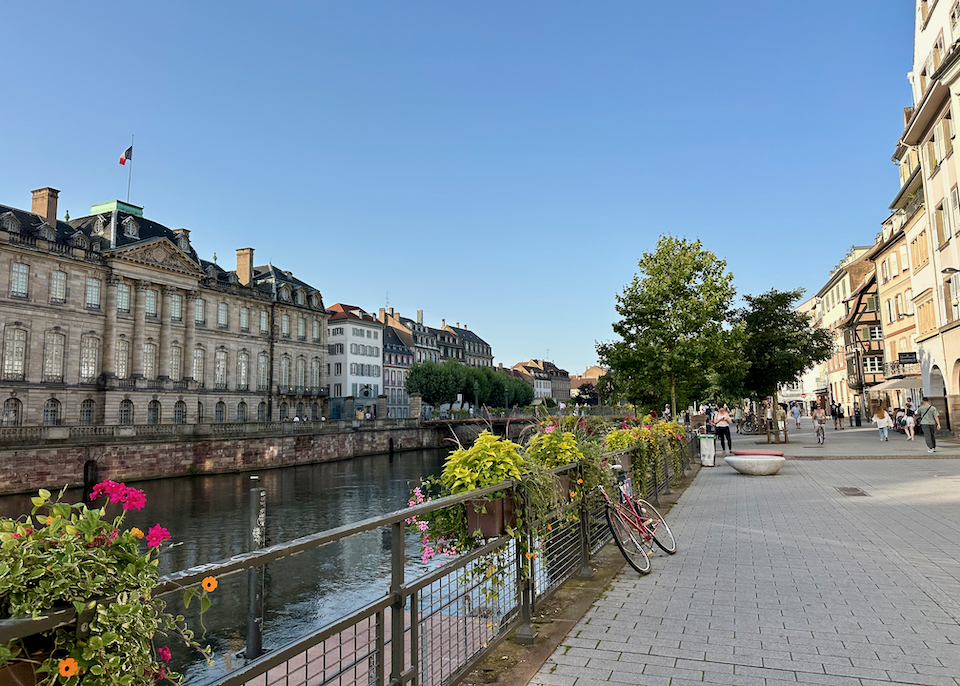
Walking along the Quai des Bateliers in the Krutenau district.
The 5 Best Neighborhoods in Strasbourg for Tourists
1. The Grande-Île and Petite France (Centre-Ville)
The historic heart of Strasbourg is the Grande-Île, a literal island surrounded by the narrow waters of the Ill River and the Canal du Faux-Rempart. The whole thing is a UNESCO World Heritage Site, a gorgeous ensemble of medieval architecture, narrow streets, cafes, and waterside restaurants that is a joy to explore on foot. Towering over it all is the sensational cathedral (Cathédrale de Notre-Dame), with its delicate medieval spire, magnificent interior, and viewing platform giving the best views of the city (332 steps up). The traffic-free zone around the cathedral is lined with shops and cafes, while the adjacent Palais Rohan houses the Strasbourg Museum of Fine Arts and the city Archaeological Museum. The neighboring Musée de l’Œuvre-Notre-Dame holds medieval and Renaissance art, while by the river, the Historical Museum of the City of Strasbourg chronicles the history of the city. (Don’t miss the huge 3-D relief map of the city, commissioned in the 1720s.)
Palais Rohan
Grande-Île’s museums are absorbing, but the best way to enjoy the old city is to simply stroll its streets and squares, grabbing coffee and cake on route. Place Gutenberg is surrounded by typical Alsatian houses with steep-pitched roofs and brightly painted facades – it’s named for the German printing press pioneer who lived in Strasbourg in the early 15th century (a statue of Johannes Gutenberg graces the center of the square).
Place Gutenberg
Wander up narrow Rue des Orfèvres to the Temple-Neuf de Strasbourg, one of the city’s Protestant churches, or up the Rue des Grandes Arcades to Place Kléber, Strasbourg’s largest square. Place du Marché-Gayot, tucked away off Rue des Frères east of the cathedral, is a pretty cobbled square full of bars and restaurants, while long, formal-looking Place Broglie is home to the opera house, city hall, and outdoor market (Wed & Fri). St. Thomas Church is the city’s premier Protestant place of worship, where 16th-century Reformation leader Martin Bucer was once pastor.
La Petite France
The southwest corner of the Grande-Île is known as La Petite France, once the home of city tradesmen and now its most picturesque quarter. Here a series of canals have created three narrow fingers of land surrounded by water, connected by the so-called “Ponts Couverts” (ancient bridges, though no longer covered, guarded by three medieval towers). Beyond here lies the Barrage Vauban, a bridge and dam built by the Marquis de Vauban (Louis XIV’s celebrated engineer) in the 1600s to protect the city from attack. Walk across it to get the best views of Petite France.
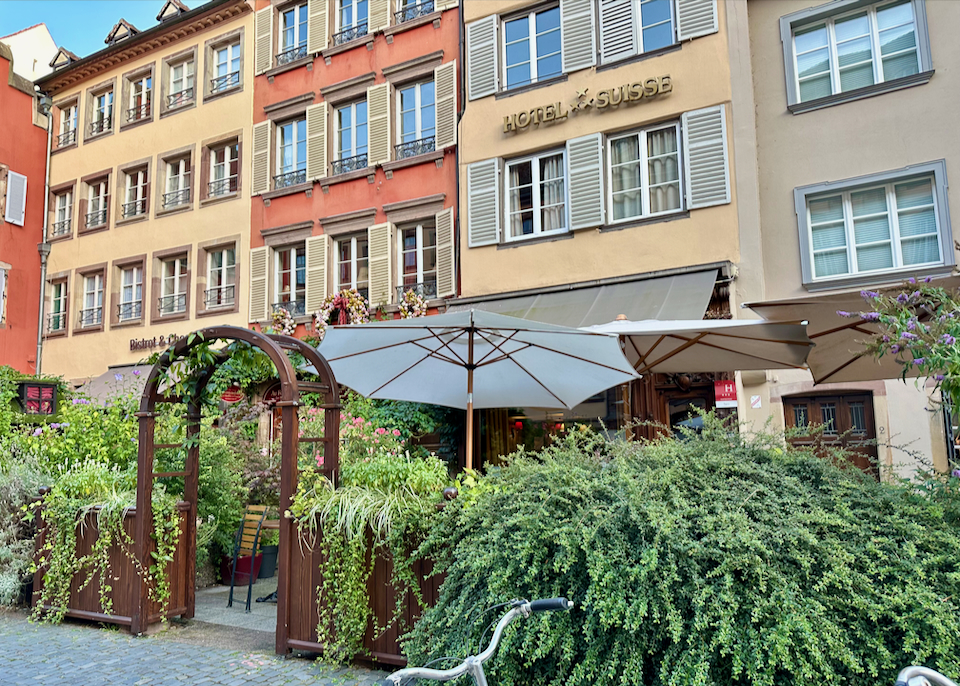
Charming Hôtel Suisse sits in a privileged and super-central location, right between the Cathedral and Palais Rohan.
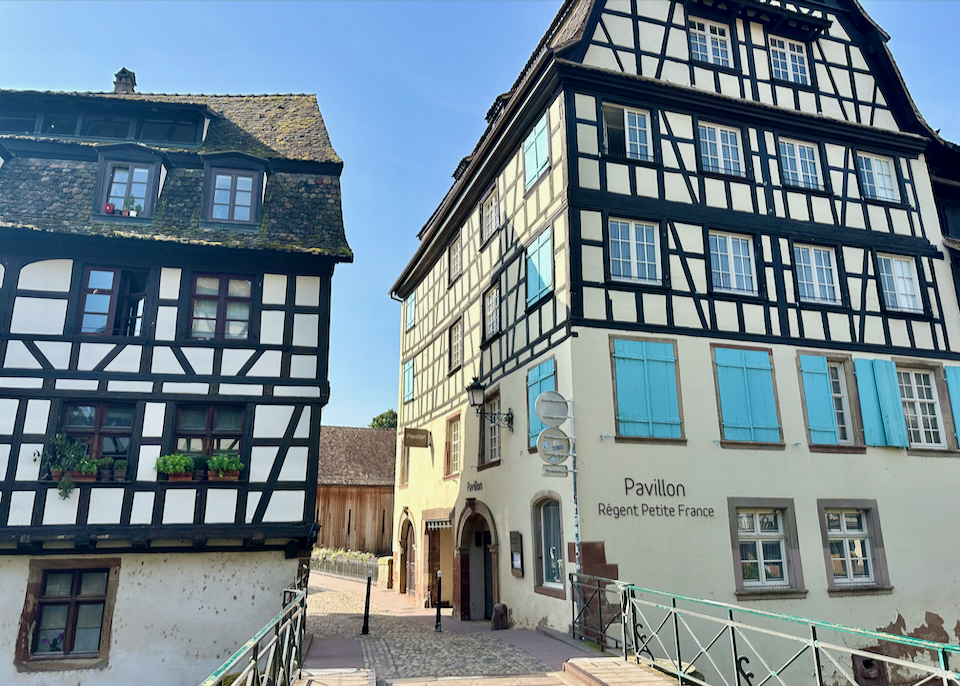
The charming, riverside Régent Petite France
- The Best Hotels in Grande-Île
Régent Petite France • Hôtel Suisse • Le Bouclier d’Or • Hôtel LÉONOR • Maison Rouge • Sofitel Grande Île- Best Cheap/Midrange Hotels
Adagio Place Kléber • BOMA • Hannong Hotel • Hotel de l’Europe • Hôtel Gutenberg2. Neustadt
Just across the river and canal northeast of the Grande-Île, the Neustadt district makes quite a contrast to its medieval, Alsatian neighbor. Most of this neighborhood was designed in the late 19th century in a grand Neoclassical style, a showcase of German power – this was to be the new city center after the German occupation of the city in 1871. (Strasbourg and the Alsace remained part of Germany until 1918.) In contrast to the old town Neustadt features wide boulevards, grand mansions, and huge plazas set on a grid plan – the transition from Grande-Île is jarring.
Around the circular Place de la République at the heart of the district lies several grand edifices: the Prussian-style Palais du Rhin (shown above), the National and University Library, and the National Theatre of Strasbourg, once the regional parliament of Alsace-Lorraine.
Strasbourg National Theatre
Nearby, the Musée Tomi Ungerer celebrates the life of award-winning Strasbourg illustrator Tomi Ungerer (1931–2019), best known for his children’s books (like Flat Stanley). Avenue de la Liberté links the Place de la République with the massive Palais Universitaire de Strasbourg (the main hall of Strasbourg University), passing the twin-towered St Paul’s Church on the way. You can visit the university building to view the stupendous Aula (Great Hall) with its giant statue of Egyptian pharaoh Ramses II, as well as the Botanical Gardens and Observatory at the back.
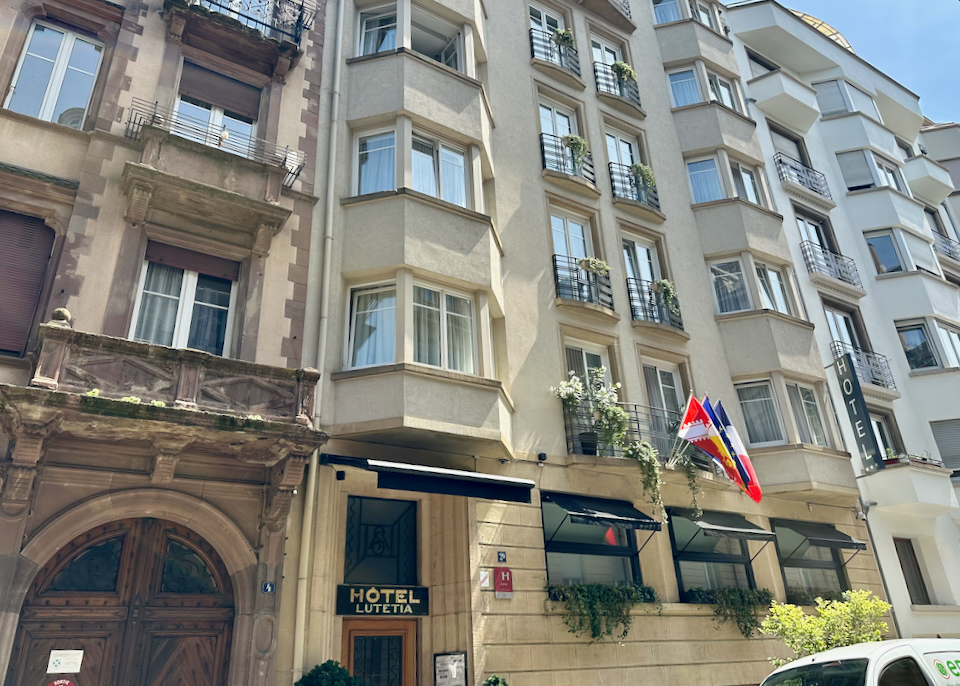
The wonderful Maison Lutetia R hotel offers spacious and comfortable rooms just around the corner from the Palais du Rhin.
- The Best Hotels in Neustadt
Hôtel Régent Contades • Maison Lutetia R- Best Cheap/Midrange Hotels
Best Western Plus Villa D’Est • Hotel D • ibis budget Centre Republique3. The European District (Quartier Européen)
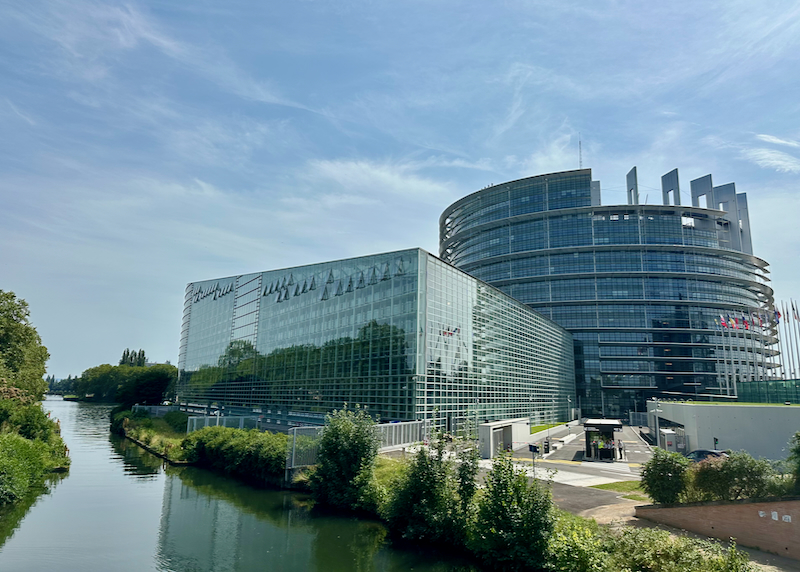
The northern section of Neustadt transitions into the more contemporary European District of wide boulevards and parks along the Ill River that contain the main European Union institutions based in Strasbourg: the squat 1970s-built home of the Council of Europe; the massive glass and steel elliptical European Parliament building (pictured above), with its intentionally unfinished tower, which opened in 1999; and the tilting silver cylinders of the European Court of Human Rights, completed in 1995. You can learn about the workings of the European Parliament at the Parlamentarium Simone Veil, and a little further north, view exhibitions on the history of the EU at Lieu d’Europe in the Kaysersguet, a former 18th-century country mansion.
Parc de l’Orangerie
Opposite the Council of Europe, the Parc de l’Orangerie, Strasbourg’s best green space, contains pleasant outdoor restaurants, ponds, playgrounds, and a small zoo.
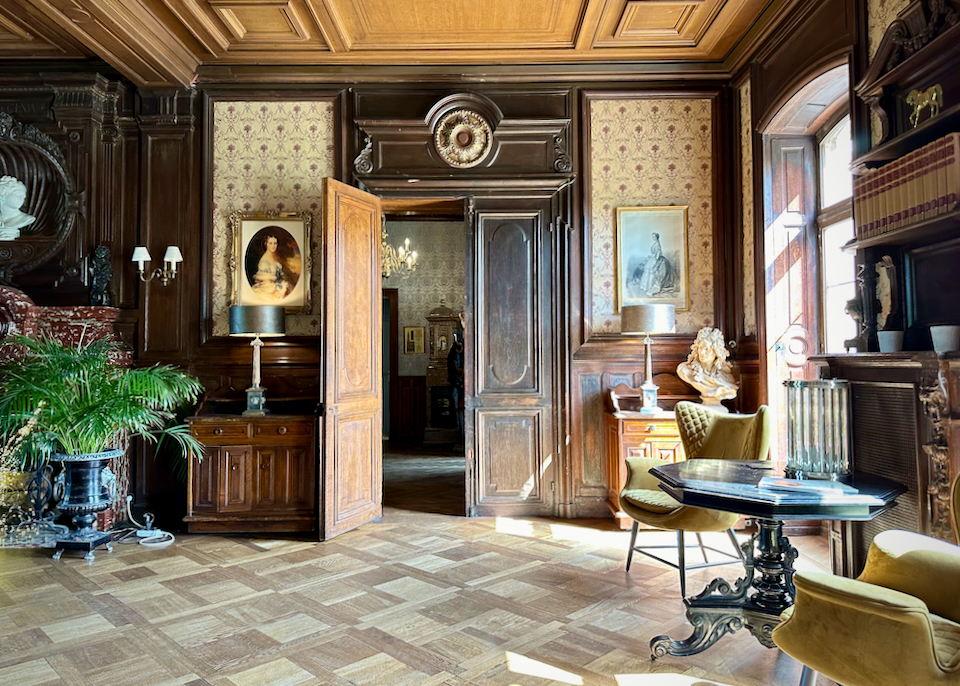
The historic Château de Pourtalès hotel sits within a 62-acre park, adjacent to the Robertsau Forest; great for walking and cycling.
- The Best Hotels in the European district
Boutique Hôtel des XV • Château de Pourtalès • Du Côté de Chez Anne- Best Cheap/Midrange Hotels
Le Jean-Sébastien Bach • Villa La Florangerie4. Bourse-Esplanade-Krutenau
The district south of the Grande-Île, across the River Ill, is far less touristy, wedged between Strasbourg University and the city’s main hospitals. The main attraction here is the Musée Alsacien just over the river, a delightful museum that showcases Alsatian history and culture inside a series of beautiful old wooden Alsatian homes. From here you can stroll along the riverbank via the traffic-free Quai des Bateliers, or grab a drink at one of the bars on the barges along Quai des Pêcheurs (above). To the south, Place d’Austerlitz is the heart of the district; a restaurant, shopping, and nightlife hub along with pedestrianized Rue d’Austerlitz.
Musée Alsacien
Within the main hospital grounds further west you can tour the Cave Historique des Hospices de Strasbourg, a 14th-century wine cellar where 50 large wooden vats still age Alsatian wines. You can also visit the 15th-century Saint-Guillaume Church, with its lopsided bell tower and ornate interior, and the nearby Haute École des Arts du Rhin (School of Arts), its facade adorned with amazing polychrome ceramic panels in the Art Nouveau style.
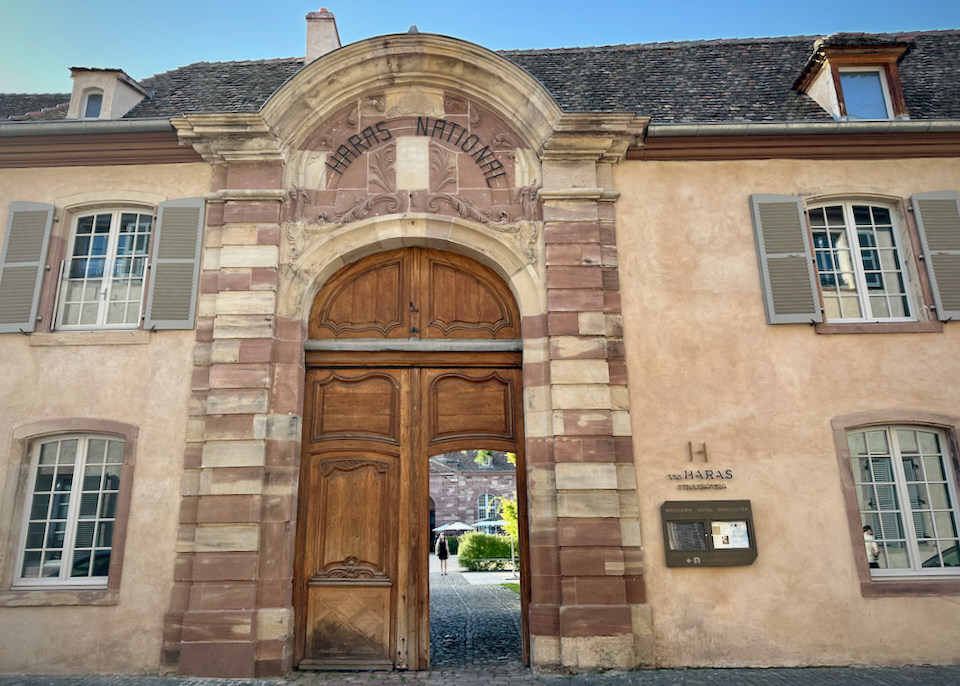
The wonderful Hotel Les Haras has an excellent location, sunny courtyard, and indoor pool.
- The Best Hotels in Bourse-Esplanade-Krutenau
Au Cerf d’Or • Cour du Corbeau • Hôtel De L’ill • Les Haras- Best Cheap/Midrange Hotels
Hôtel Beaucour • Hôtel du Dragon • Chambre d’hôtes La Célestine5. Gare-Tribunal
This district surrounds the city’s massive train station (“La Gare”) across the canal on the west side of Grande-Île – it’s the most convenient place to stay if you’re traveling by train, with the added bonus of being only a short walk from the historic center via largely pedestrianized Rue du Maire Kuss (and Rue du 22 Novembrein Grande-Île).
Musée d’Art Moderne et Contemporain
The biggest attraction here lies to the south of the station, just across from Petite-France and Barrage Vauban; the Musée d’Art Moderne et Contemporain de Strasbourg presents a decent collection of modern and contemporary art in a sleek modern glass-fronted building, with works by Kandinsky, Picasso, Pissarro, Renoir, and Strasbourg’s own Jean Arp, among many others. Art fans should also check out the Château Musée Vodou, which displays the largest collection of West African voodoo artifacts in the world, inside a 19th century water tower. To the south is Strasbourg’s alternative theater and performance district, home to venues such as La Laiterie and Le Molodoï.
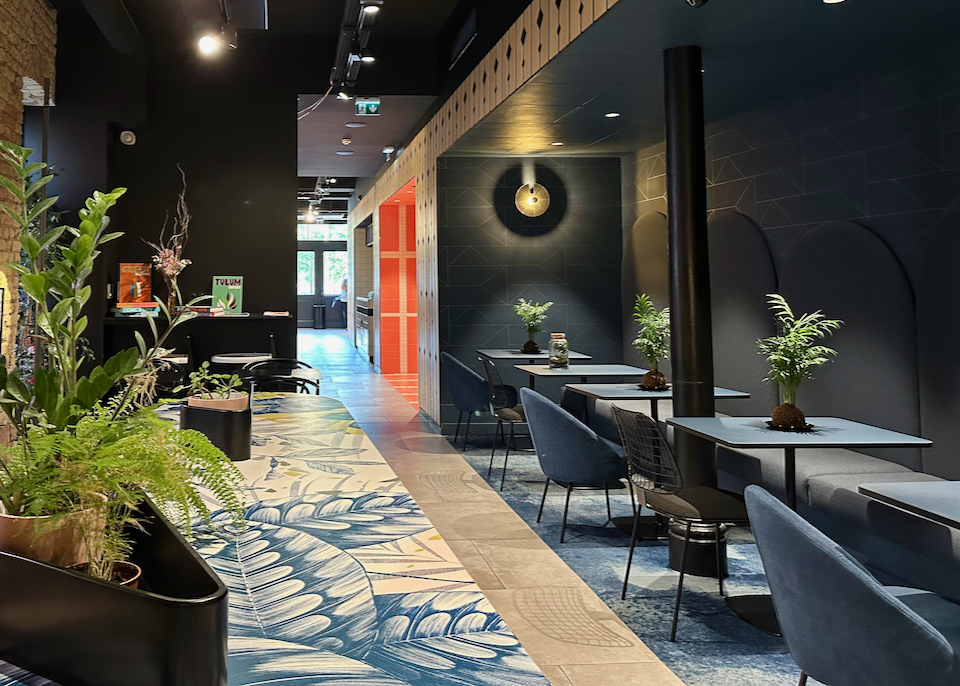
Stylish Hotel Tandem is the best hotel near the Strasbourg central train station.
- The Best Hotels in Gare-Tribunal
Graffalgar • Hôtel des Vosges • Mercure Petite France • Hotel Tandem • voco Strasbourg Centre – The Garden- Best Cheap/Midrange Hotels
Best Western Plus Monopole Métropole • Hôtel Arok • Hotel Strasbourg – Montagne Verte • Hôtel Vendôme Strasbourg
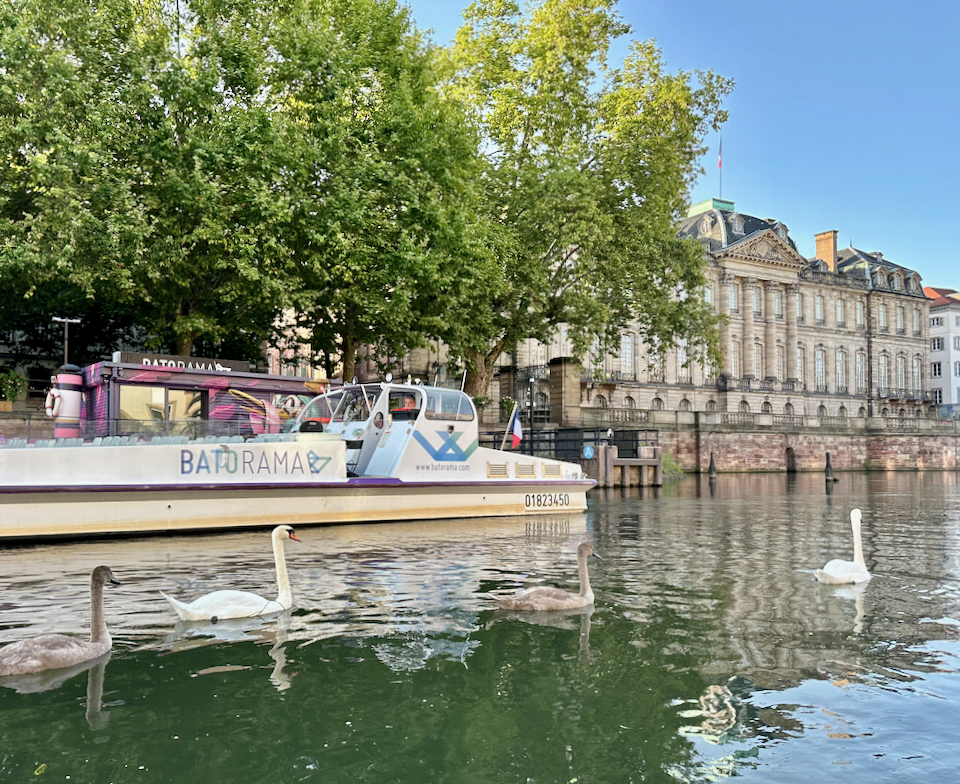
It’s worth taking the time to see Strasbourg from the water. Batorama runs various cruises from its pier on the Ill River in front of the Palais Rohan, including runs up to the Barrage Vauban and the European Parliament.
Strasbourg Travel Tips
- While it’s best to explore Strasbourg’s historic Grande-Île on foot, you’ll need to use its excellent public transport system to go further afield. The system comprises buses and the futuristic Strasbourg six-line tramway (€2 single tickets, €4.60/24hr). It can be useful to have a rental car when exploring the area around the city, but there’s really no need to use one in Strasbourg itself (much of the city center is a pedestrian priority zone, so it’s best to park in one of the lots outside the Grande-Île anyway).
- Note that when the European Parliament is in session (around once a month from Monday to Thursday), hotels in Strasbourg can become expensive and/or full. To find out in advance when the parliament is sitting visit europarl.europa.eu.
- Exploring Strasbourg by bicycle can be fun, with a dedicated path and trail network of around 600km. Bike rental is readily available through the Vélhop bikeshare system, which operates 6,000 bicycles.
- Strasbourg Airport lies around 6 miles (10km) southwest of the city center. Trains zip between the airport and main train station in around 7 minutes. The airport serves primarily European destinations, but there are no flights to Paris; the high-speed LGV Est train service takes less than 2 hours.
- The Strasbourg City Card (€6.50) offers discounts in museums, hotels, restaurants, and tourist attractions for up to 7 days. You only need to visit three or more attractions to make it worthwhile. Visit the tourist information office at 17 place de la Cathédrale to purchase. If you intend to visit a lot of museums, also consider the Museums-PASS-Musées card, which is €16 for one day and €20 for three days (the latter is much better value) – it gives free entry to all of them. All the city’s museum’s cost €7.50, so if you visit three or more, the card will save you money.
- You’ll find plenty of English speakers in cosmopolitan Strasbourg, but it’s still useful to learn a few words and numbers in French before you go – don’t assume everyone understands English.
- Free wi-fi is available at Strasbourg Airport, but in the city yourself you’ll need to access local hotspots at cafes, bars and restaurants (most of which offer free wi-fi).
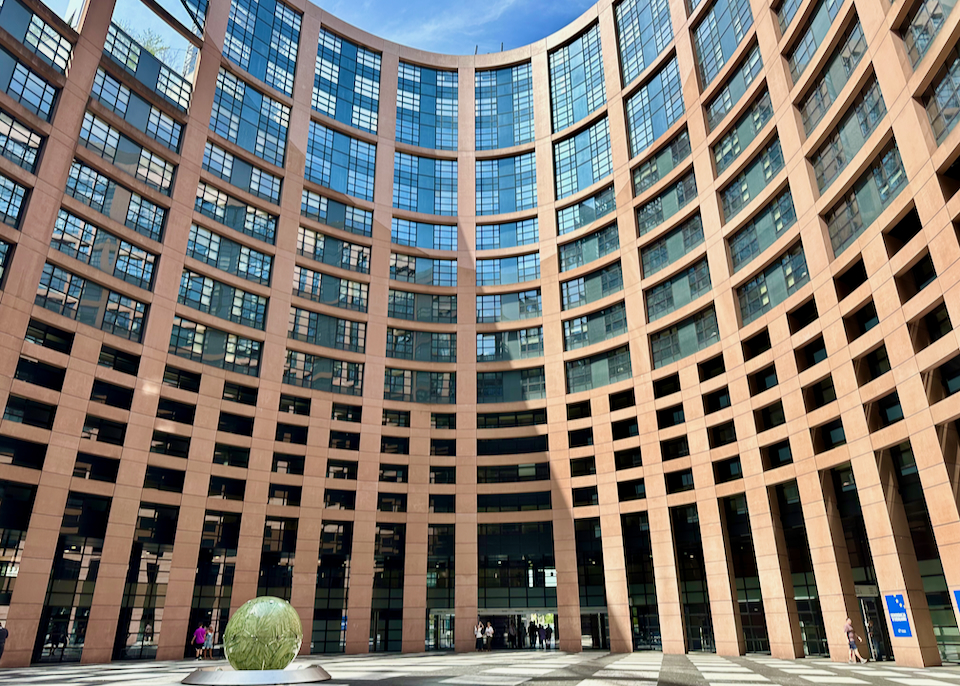
It’s interesting to visit the European Parliament Building and witness the heart of European democracy. Guided tours and visits are free, but often require advance booking; visit during plenary sessions (usually one week per month) to see the Parliament in action — check the official website for the schedule.
Other Strasbourg Neighborhoods
We’ve covered our favorite neighborhoods to visit and stay in more detail above, but with more time these places are also worth checking out:
- La Route des Vins d’Alsace: Strasbourg makes a good base for exploring Alsace’s picturesque Wine Route, flanked by the southern Vosges mountains and the River Rhine. The route (best tackled by car) passes almost 70 wine growing villages and 1,000 wine producers, best known for excellent Gewürztraminer, Pinot Noir, and Riesling varietals (as well as the local bubbly, Crémant d’Alsace).
- Colmar: Some 43 miles (70km) south from Strasbourg (35 minutes by train), this is a classic Alsatian old town, full of fairy tale half-timbered, multicolored houses, narrow canals, and pretty Gothic churches. Highlights include the 16th-century Isenheim Altarpiece in the Unterlinden Museum and Martin Schongauer’s masterwork “Madonna of the Rose Bush” in the Dominican Church, but it’s an enchanting place to simply stroll around. The best hotel in Colmar is the wonderful La Maison des Têtes, but it’s expensive; good but cheaper hotels in the old center include ibis Styles, Hôtel Saint-Martin, and Hôtel Le Maréchal.
- Koenigshoffen: This western suburb of Strasbourg has a smattering of intriguing sights to check out if you’re staying in the city for more than a few days; the Tour Merveilleuse du Schloessel (Schloessel Tower) features a lovely café and park-like grounds, the Parc Albert-Schweitzer (named after the famed humanitarian who lived and studied here in the early 20th century), and the historic Jewish Cemetery (Cimetière Juif de Koenigshoffen). There’s not much point in staying out here unless you want to put up a tent at Camping de Strasbourg, near the river.
- There’s little reason to stay near Strasbourg Airport (Aéroport de Strasbourg) to the southwest of the city unless you have a very early flight. (Trains take just 7 minutes to get to the airport from Strasbourg main station.) If you do need to stay here, there’s only one good option nearby: B&B Hotel, though the Hôtel Père Benoît in the village of Entzheim isn’t that far away by taxi.
Summary: My Favorite Hotel in Strasbourg
My Favorite Strasbourg Hotels
• 5-Star Hotel: Cour du Corbeau
• Boutique Hotel: Hôtel LÉONOR
• Cheap Hotel: Hannong Hotel
• Family Hotel: Hôtel Suisse
• Indoor Pool: Les Haras
• Outdoor Pool: Villa La Florangerie
• Near Train Station: Hotel Tandem
• Near Airport: B&B Hotel
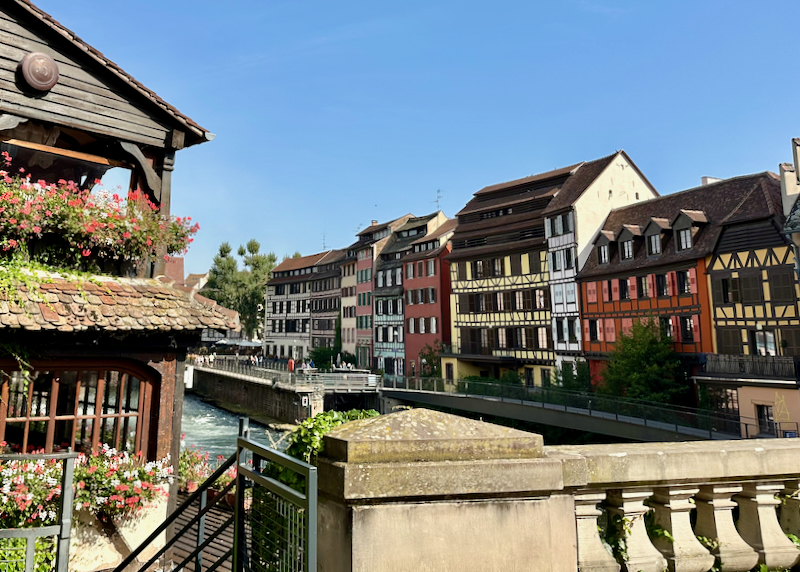
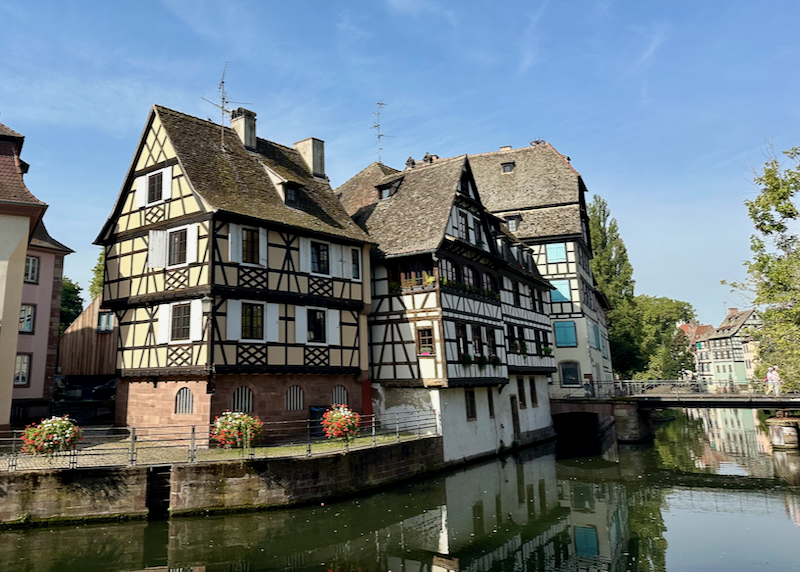


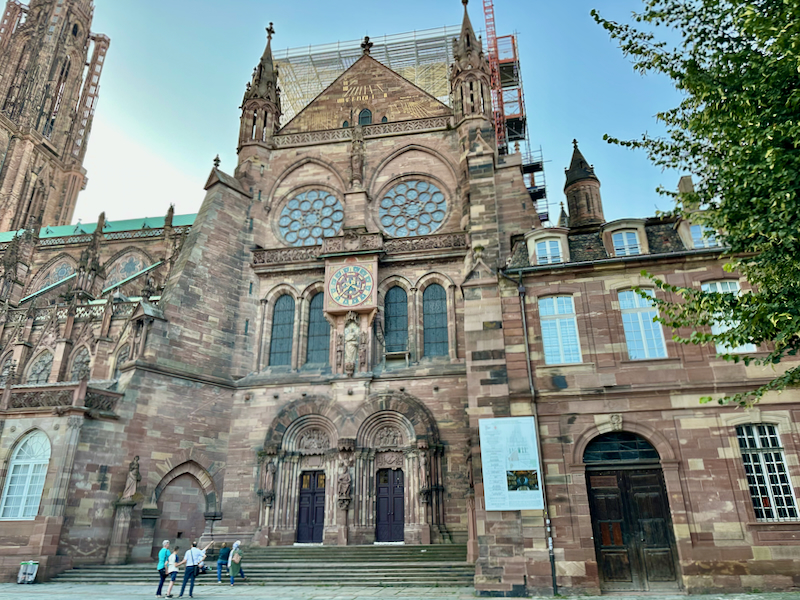
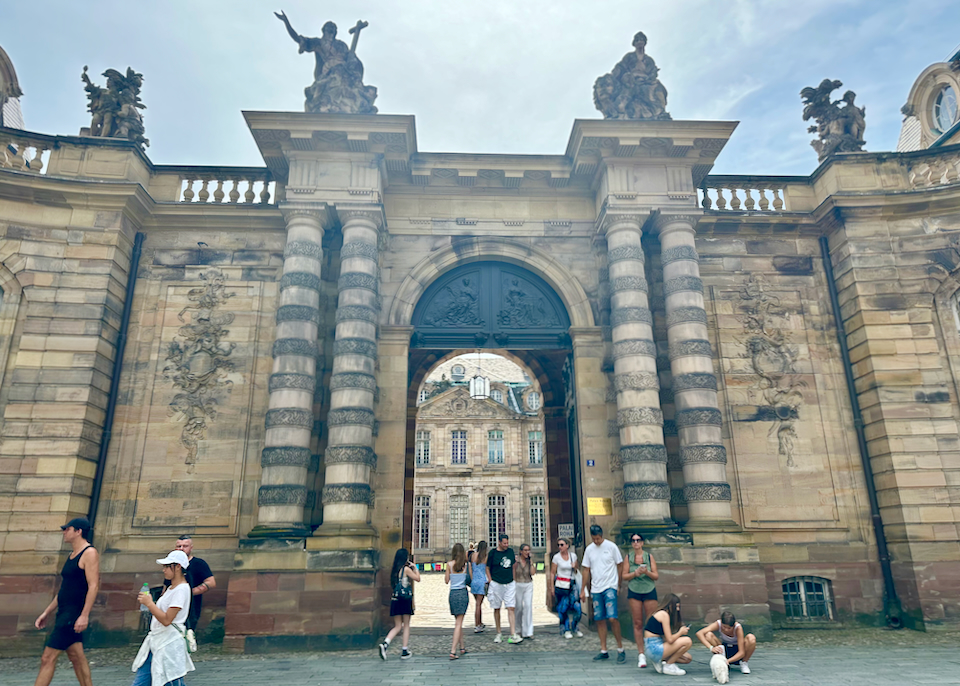
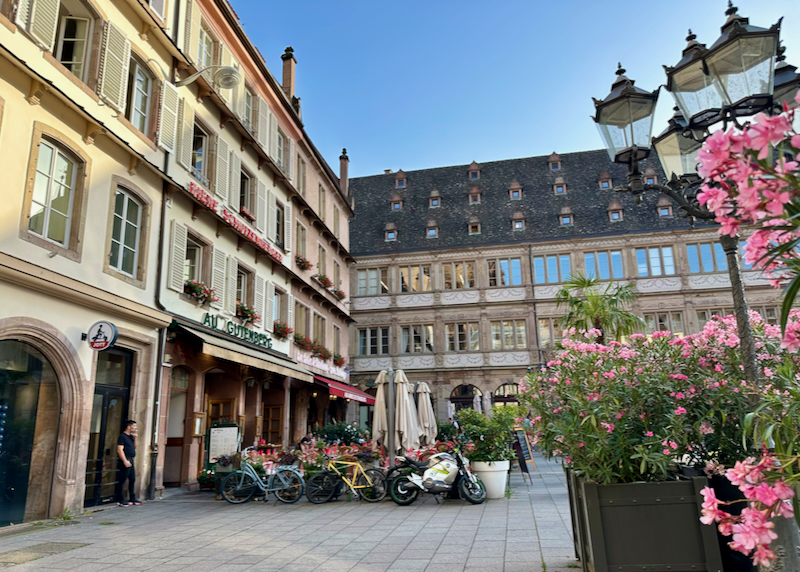
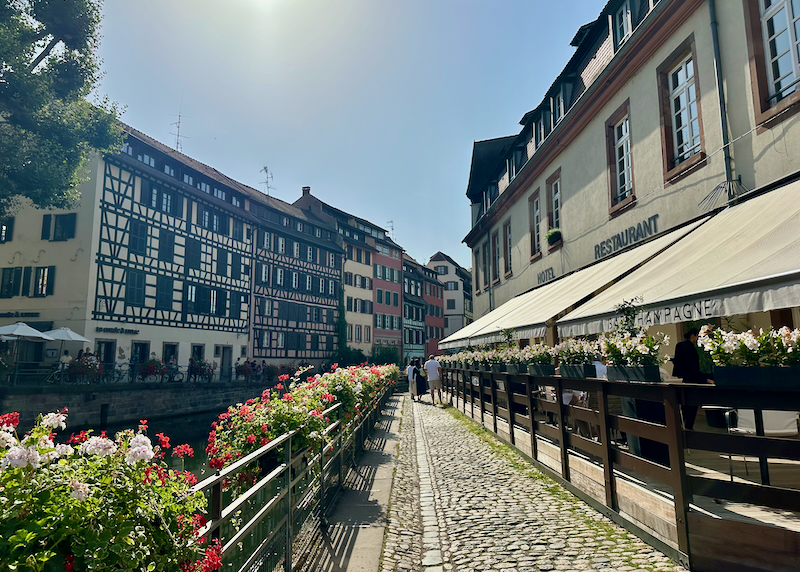
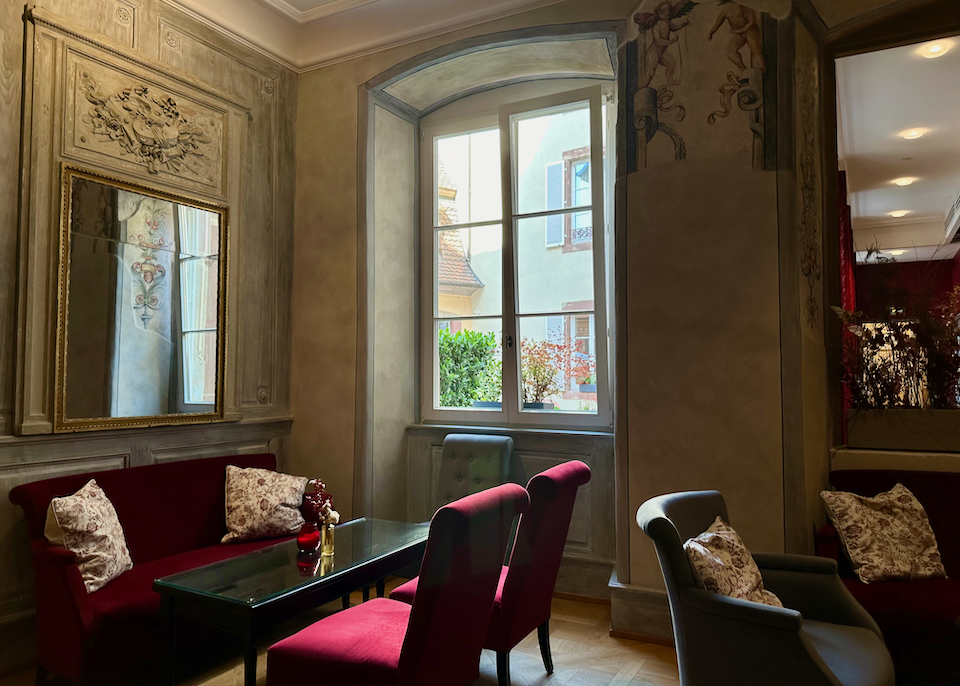
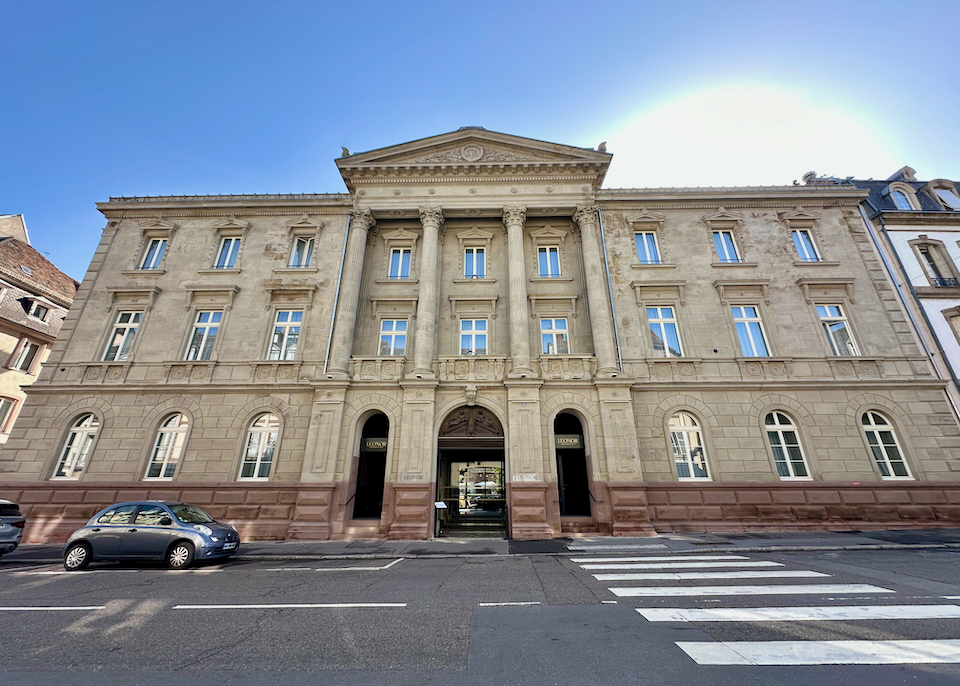
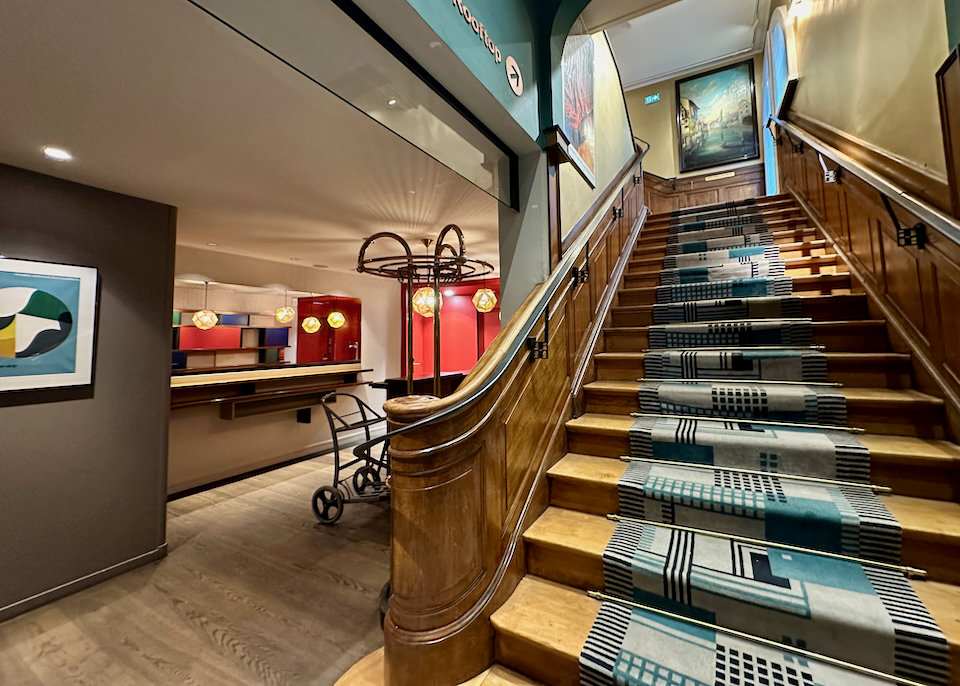
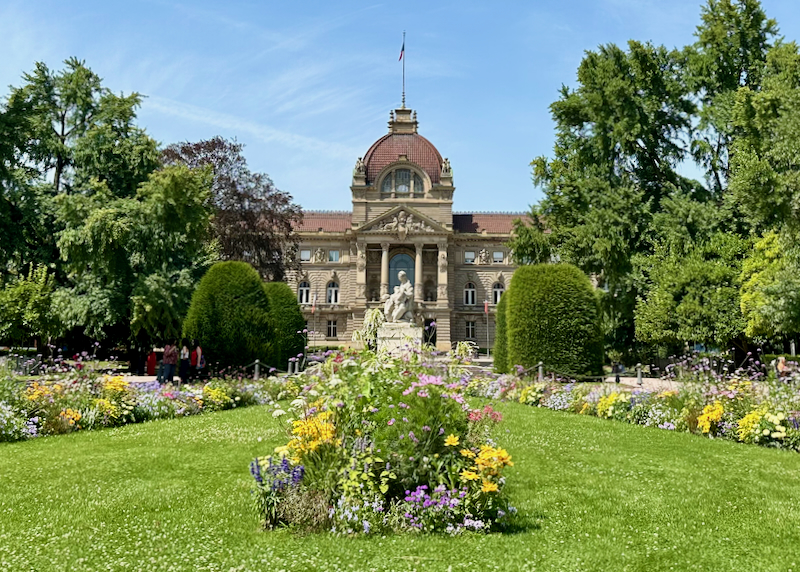

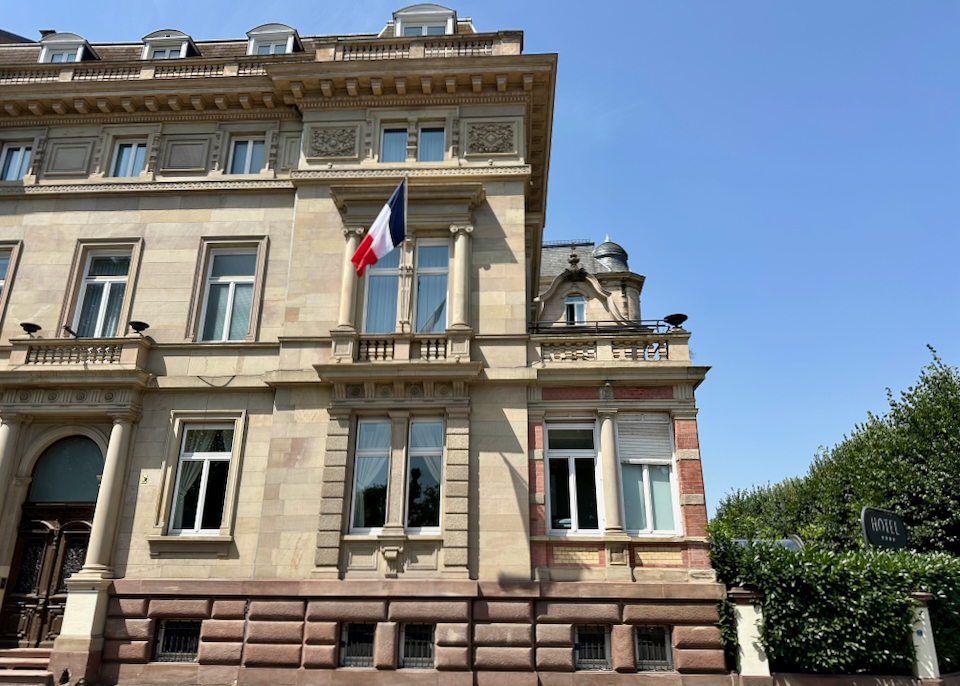
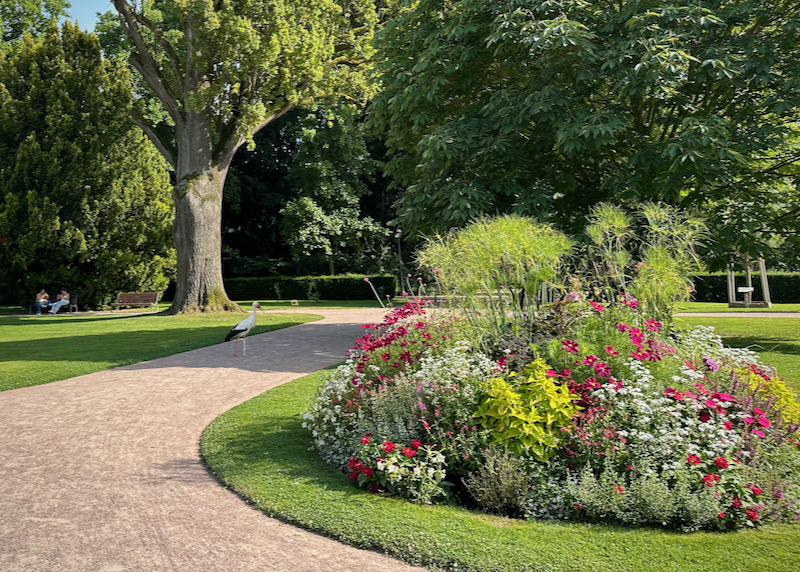
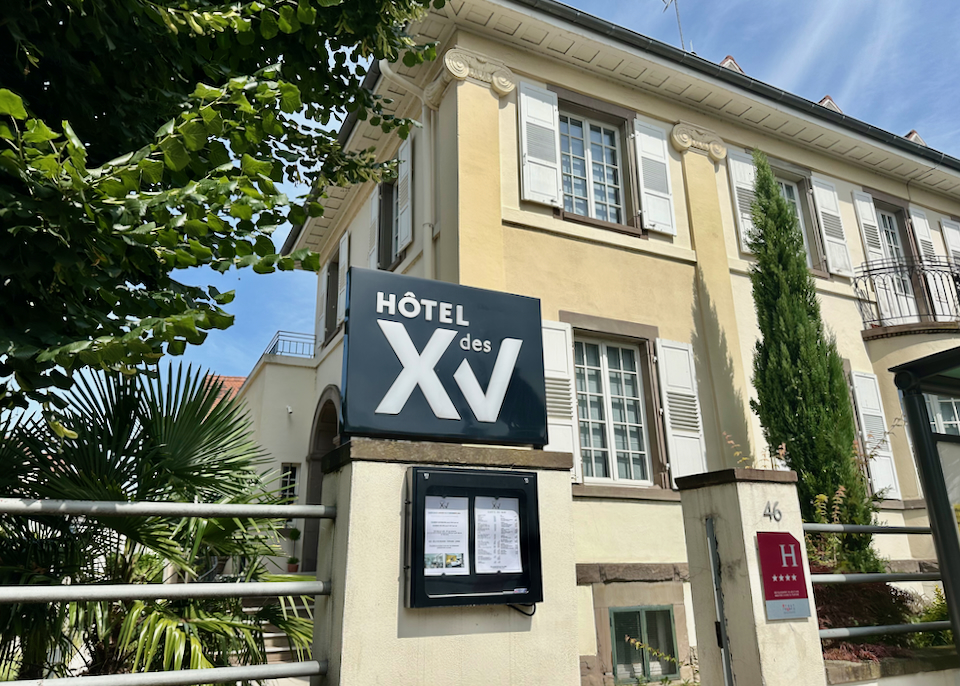
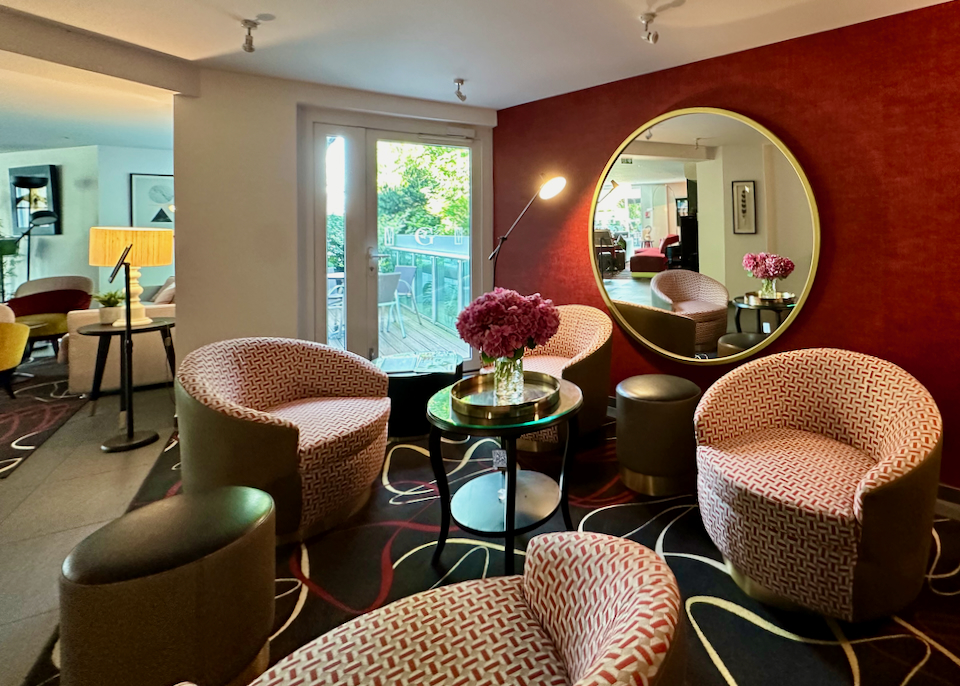
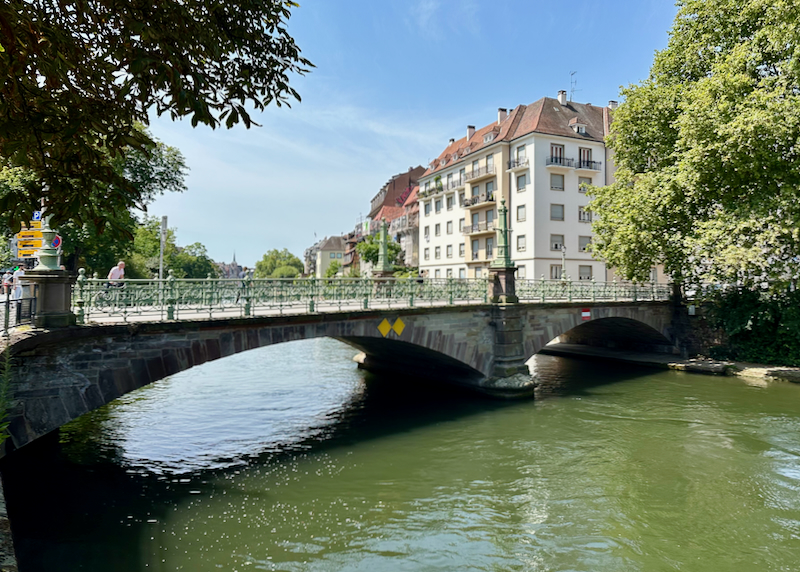
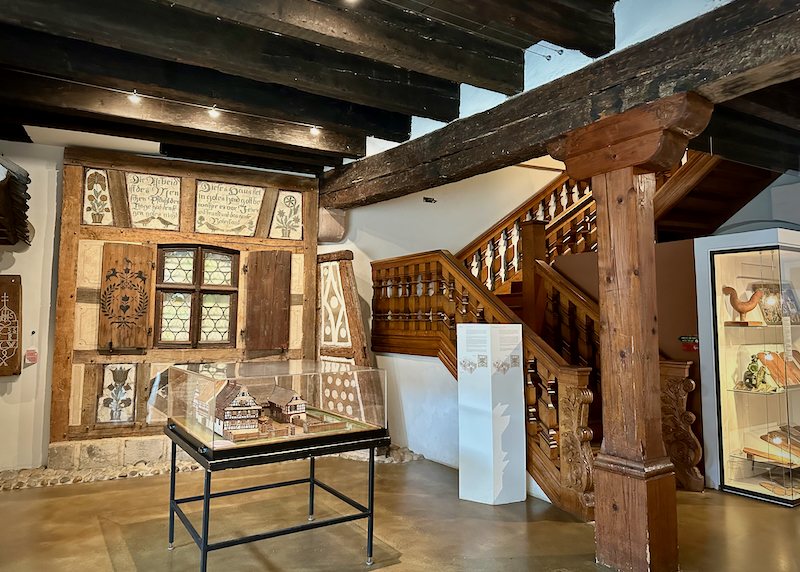
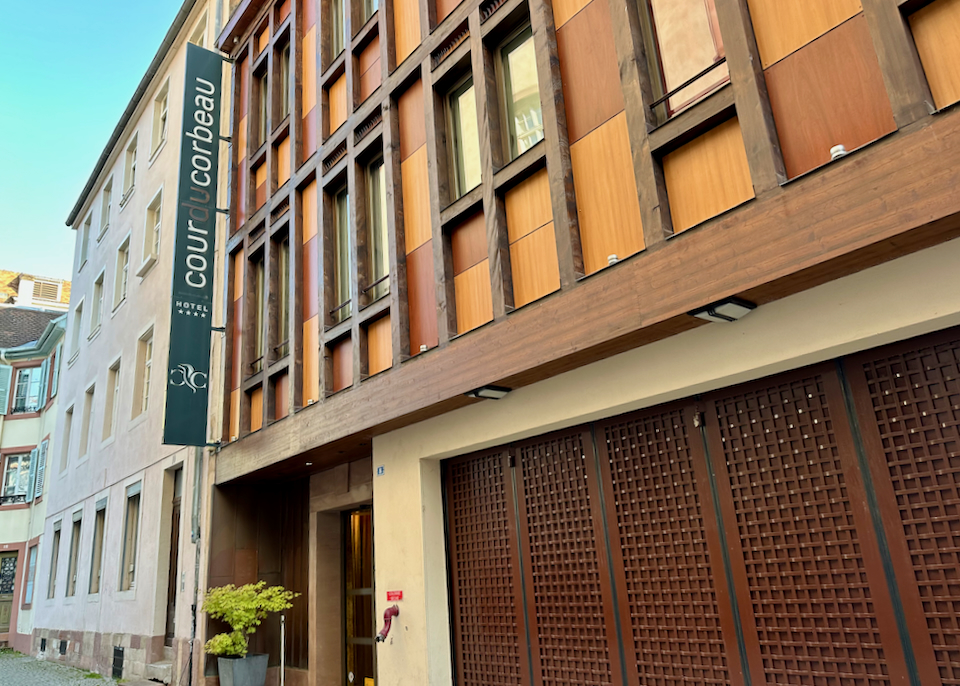
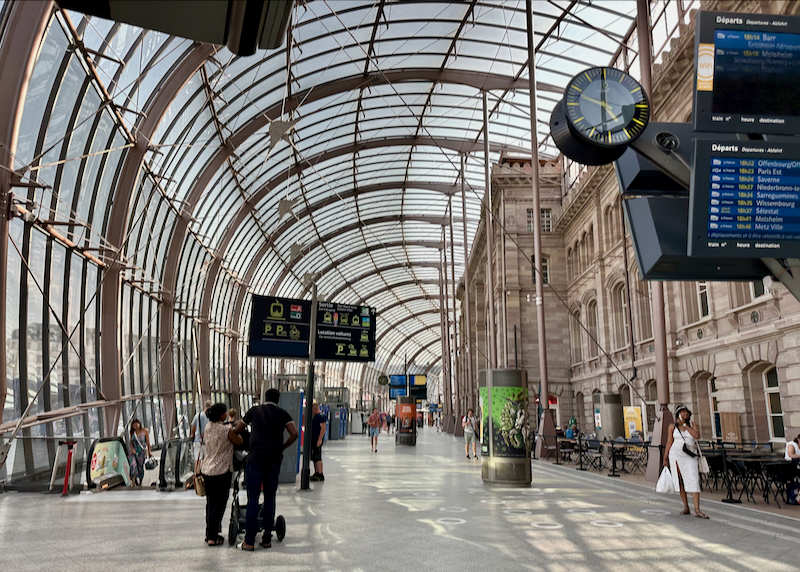
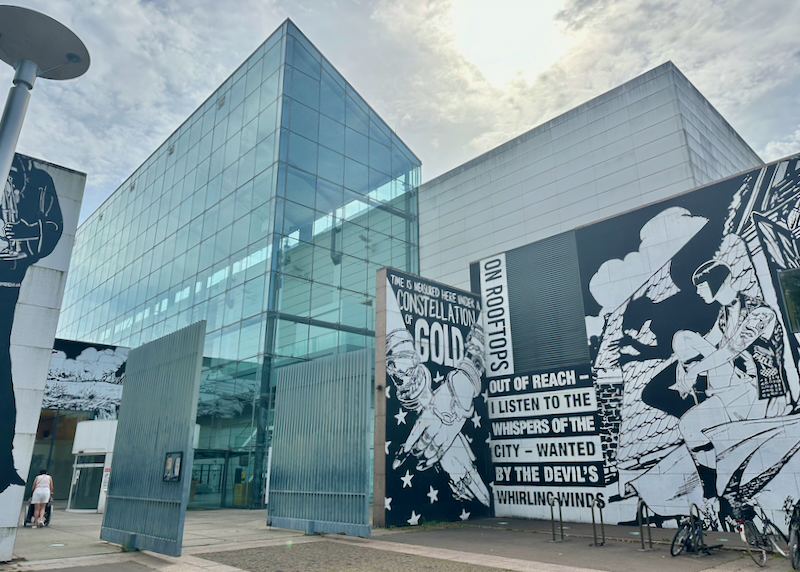
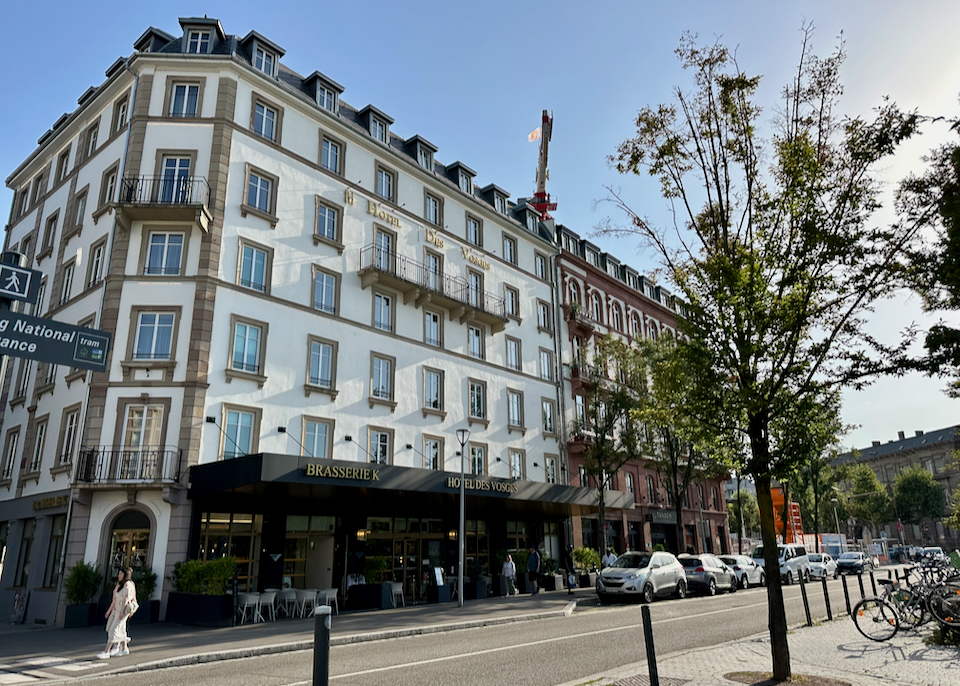
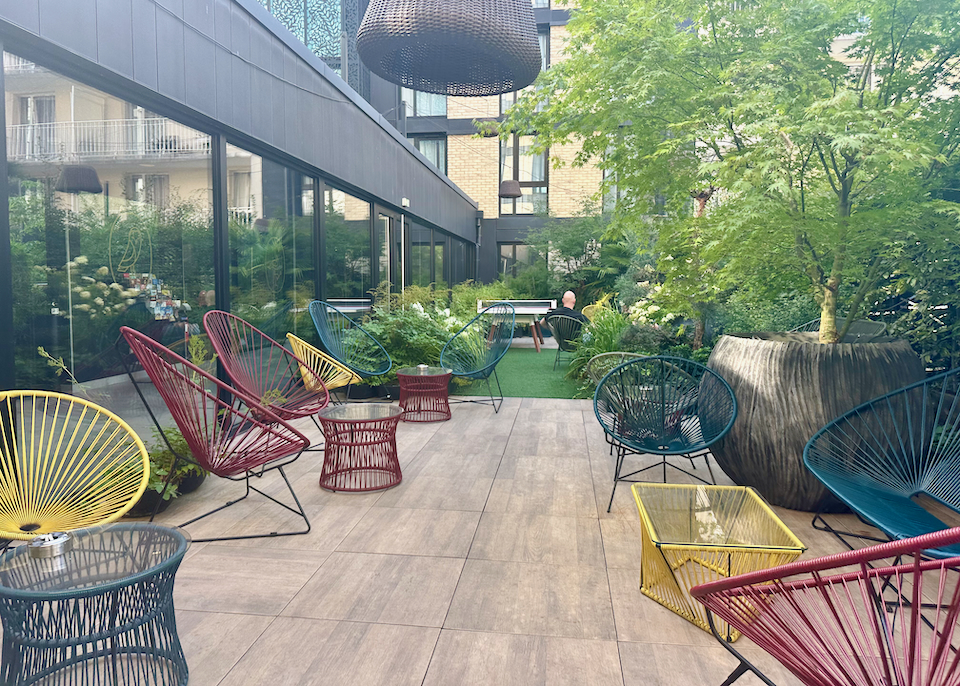
About Santorini Dave